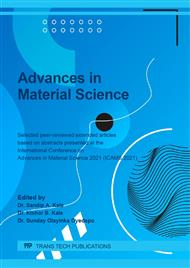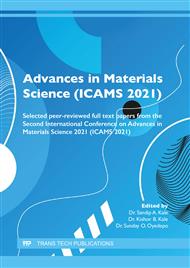[1]
P. Elliott, Overcome the challenge of high temperature corrosion, in Corrosion, Houston, TX, USA (2011).
Google Scholar
[2]
P. Elliott, Materials performance in high temperature environments - making the choice, in Corrosion, Orlando, FL, USA (2000).
Google Scholar
[3]
R.C. John, I.G. Wright, Long-term oxidation commercial alloys in PO2's of 0.001 - 1 atma, at temperatures of 200 - 1,150ºC and after 20,000 hr, in corrosion, New Orleans, LA, USA (2004).
Google Scholar
[4]
D.L. Klarstrom, S.K. Srivastava, Selection of high performance alloys for high temperature corrosion environments, in Corrosion, Houston, TX, USA (2005).
Google Scholar
[5]
Principal Features, HAYNES HR-120 alloy, Haynes International. Available: https://www.haynesintl.com/alloys/alloy-portfolio_/High-temperature-Alloys/HAYNES-HR-120-ALLOY.aspx. [Accessed 25-May-2021].
DOI: 10.31399/asm.ad.ni0395
Google Scholar
[6]
Heat Resistant Alloys, NAS H38X (UNS N08120), Nippon Yakin Kogyo Co., Ltd. Available: https://www.nyk.co.jp/en/products/alloys/heat/h38x.html. [Accessed 25-May-2021].
Google Scholar
[7]
W.J. Matthews, K.L. More, L.R. Walker, Long-term microturbine exposure of an advanced alloy for microturbine primary surface recuperators, in Proceedings of ASME Turbo Expo 2008: Power for Land, Sea and Air GT2008, Berlin, Germany (2008).
DOI: 10.1115/gt2008-50037
Google Scholar
[8]
M.D. Rowe, V.R. Ishwar, D.L. Klarstrom, Properties, Weldability, and applications of modern, wrought, heat-resistant alloys for aerospace and power generation industries, in ASME Turbo Expo 2004: Power for Land, Sea, and Air, Vienna, Austria (2004).
DOI: 10.1115/gt2004-54309
Google Scholar
[9]
K. Son, T.Q. Phan, L.E. Levine, K. Kim, K. Lee, M. Ahlfors, M.E. Kassner, The creep and fracture properties of additively manufactured inconel 625, Materialia 15 (2021) 1010-21.
DOI: 10.1016/j.mtla.2021.101021
Google Scholar
[10]
An International Code 2010: ASME Boiler & Pressure Vessel Code II - Part B - Nonferrous Material Specifications, ASME, New York, USA (2011).
Google Scholar
[11]
M.A. Harper, G.Y. Lai, Nickel-based alloys for resistance to high-temperature corrosion, in Environmental Effects on Engineered Materials, CRC Press (2001) 35.
DOI: 10.1201/9780203908129.ch4
Google Scholar
[12]
A. Viswanath, H. Dieringa, K.K.A. Kumar, U.T.S. Pillai, B.C. Pai, Investigation on mechanical properties and creep behavior of stir cast AZ91-SiCp composites, Journal of Magnesium and Alloys 3 (2015) 16-22.
DOI: 10.1016/j.jma.2015.01.001
Google Scholar
[13]
X. Zhao, Y. Qi, J. Wang, Z. Zhang, J. Zhu, L. Quan, Effect of cast defects on the corrosion behavior and mechanism of UNS c95810 alloy in artificial seawater, Materials 13 (2020) 1790.
DOI: 10.3390/ma13071790
Google Scholar
[14]
M. Perzyk, A. Kochanski, Detection of causes of casting defects assisted by artificial neural networks, Proceedings of the Institution of Mechanical Engineers, Part B: Journal of Engineering Manufacture 217 (2003) 1279-1283.
DOI: 10.1243/095440503322420205
Google Scholar
[15]
N. Mahomed, H. A. Kleynhans, Reducing shrinkage porosity in high-performance steel castings: case of an ASME b16.34 gate valve body: part 2—simulation and experimental verification, International Journal of Metalcasting 13 (2019) 463–472.
DOI: 10.1007/s40962-018-0275-7
Google Scholar
[16]
S. Ramrattan, Evaluating a ceramic resin-coated sand for aluminum and iron castings, International Journal of Metalcasting 13 (2019) 519-527.
DOI: 10.1007/s40962-018-0269-5
Google Scholar
[17]
M.A.A. Khan, A.K. Sheikh, Simulation tools in enhancing metal casting productivity and quality: A review, Proceedings of the Institution of Mechanical Engineers 230 (2016) 1799-1817.
DOI: 10.1177/0954405416640183
Google Scholar
[18]
L.K.P. Lukáš, R. Konečná, S. Fintová, Casting defects and high temperature fatigue life of IN 713LC superalloy, International Journal of Fatigue 41 (2012) 47-51.
DOI: 10.1016/j.ijfatigue.2011.12.002
Google Scholar
[19]
B.N. Rao, R. Ashokkumar, Effect of blow-holes on reliability of cast component, Sadhana 33 (2008) 733–751.
DOI: 10.1007/s12046-008-0031-4
Google Scholar
[20]
M.L. Skryabin, V.A. Likhanov, The study of casting defects in steel 35HGSL, Journal of Physics: Conference Series 1399 (2019) 044063.
DOI: 10.1088/1742-6596/1399/4/044063
Google Scholar
[21]
J. Zhang, T. Huang, L. Liu, H. Fu, Advances in solidification characteristics and typical casting defects in nickel-based single crystal superalloys, Acta Metallurgica Sinica 51 (2015) 1163-1178.
Google Scholar
[22]
E.M. Gutman, Y. Unigovski, M. Levkovitch, Z. Koren, Influence of Porosity and Casting Conditions on Creep of Die-cast Mg Alloy, Journal of Materials Science Letters 17 (1998) 1787–1789.
DOI: 10.1023/a:1006601419020
Google Scholar
[23]
B. Han, W.J. Wan, C.L. Zhu, J. Zhang, J.H. Yi, Effect of casting defects on high cycle fatigue life of fully lamellar TiAl alloy, Materials Research Innovations 19 (2015) S142-S146.
DOI: 10.1179/1432891715z.0000000001530
Google Scholar
[24]
X. Zang, L. Liu, C. Yang, J. Zhang, Y. Li, H. Fu, Advance in research of casting defects of directionally solidified nickel-based single superalloys, Journal of Materials Engineering 2 (2012) 93-98.
Google Scholar
[25]
K. Samvatsar, H. Dave, Study on Defect Reduction in Casting of Ni-Cr alloy (UNS N06003), IOP Conference Series: Materials Science and Engineering 1225 (2022) 012065.
DOI: 10.1088/1757-899x/1225/1/012065
Google Scholar
[26]
N. Bannenberg, B. Bergmann, H. Gaye, Combined decrease of sulphur, nitrogen, hydrogen and total oxygen in only one secondary steelmaking operation, Steel Research 63 (1992) 431-437.
DOI: 10.1002/srin.199201737
Google Scholar
[27]
N. Masumitsu, K. Ito, R. J. Fruehan , Thermodynamics of Ca-CaF2 and Ca-CaCl2 systems for the dephosphorization of steel, Metallurgical Transactions B 19 (1988) 643–648.
DOI: 10.1007/bf02659156
Google Scholar
[28]
L. Lu, S. Devasahayam, V. Sahajwalla, 14 - Evaluation of coal for metallurgical applications, in The Coal Handbook: Towards Cleaner Production - Coal Utilisation - Volume 2, Woodhead Publishing Limited (2013) 352-386.
DOI: 10.1533/9781782421177.3.352
Google Scholar
[29]
S. Trivedi, P. Gupta, Effect of phosphorus addition in steel: processed through cast route and powder metallurgy route, Journals of Mechatronics Machine Design and Manufacturing 1 (2019) 24-28.
Google Scholar
[30]
J. Guo, W. Yang, X. Shi, Z. Zheng, S. Liu, S. Duan, J. Wu, H. Guo, Effect of sulfur content on the properties and mns morphologies of DH36 structural steel, Metals 8 (2018) 945.
DOI: 10.3390/met8110945
Google Scholar
[31]
W. Wang, S. Luo, Z. Cai, M. Zhu, The effect of phosphorus and sulfur on the crack susceptibility of continuous casting steel, in Materials Processing Fundamentals, Springer, Cham (2013) 89-98.
DOI: 10.1002/9781118662199.ch10
Google Scholar
[32]
B. Şener, R. Hüsken, J. Cappel, Desulphurization strategies in oxygen steelmaking, in AISTech 2012 - The Iron & Steel Technology Conference and Exposition, Atlanta, GA (2012).
Google Scholar
[33]
F. Xiong, R. Fu, Y. Li, B. Xu, X. Qi, Influences of nitrogen alloying on microstructural evolution and tensile properties of CoCrFeMnNi high-entropy alloy treated by cold-rolling and subsequent annealing, Materials Science and Engineering: A 787 (2020) 139472.
DOI: 10.1016/j.msea.2020.139472
Google Scholar
[34]
Z. Jiang, H. Li, Z. Chen, Z. Huang, D. Zou, L. Liang, The nitrogen solubility in molten stainless steel, Steel Research International 76 (2016).
DOI: 10.1002/srin.200506090
Google Scholar
[35]
A.G. Svyazhin, L.M. Kaputkina, V.E. Bazhenov, Z. Skuza, E. Siwka, V.E. Kindop, Phases and defects upon the solidification of nitrogen-alloyed stainless steels, The Physics of Metals and Metallography 116 (2015) 552–561.
DOI: 10.1134/s0031918x15060095
Google Scholar
[36]
I. Woo, Y. Kikuchi, Weldability of high nitrogen stainless steel, ISIJ International 42 (2002) 1334–1343.
DOI: 10.2355/isijinternational.42.1334
Google Scholar
[37]
J. Desai, V. Parikh, T. Shah, Reducing porosity for alloy steel casting, International Journal of Engineering Research & Technology 2 (2013) 871-874.
Google Scholar
[38]
Srinath Viswanathan et al. (Eds.), ASM Handbook Volume 15: Casting., Ohio, USA: ASM International (2008).
Google Scholar
[39]
B.D. Jana, A.K. Chakrabarti, A study on the mechanism of desulphurisation and dephosphorisation of liquid steel by Na2CO3 flux treatment, Scandinavian Journal of Metallurgy 33 (2004) 76-79.
DOI: 10.1111/j.1600-0692.2004.00666.x
Google Scholar
[40]
A. Freismuth, The use of calcium carbide in ferrous metallurgy, Metallurgist 41 (1997) 56-60.
DOI: 10.1007/bf02764762
Google Scholar
[41]
N. Maruoka, A. Ito, M. Hayasaka, H. Nogami, Effect of CO2 Content in Quicklime on Dissolution Rate of Quicklime in Steelmaking Slags, ISIJ International 57 (2017) 1684-1690.
DOI: 10.2355/isijinternational.isijint-2017-261
Google Scholar
[42]
Y. Liu, L. Zhang, Relationship between dissolved calcium and total calcium in Al-killed steels after calcium treatment, Metallurgical and Materials Transactions B 49 (2018) 1624–1631.
DOI: 10.1007/s11663-018-1288-6
Google Scholar
[43]
G. Yang, X. Wang, Inclusion evolution after calcium addition in low carbon Al-killed steel with ultra low sulfur content, ISIJ International 55 (2015) 126-133.
DOI: 10.2355/isijinternational.55.126
Google Scholar
[44]
S. Sanyal, D. Mishra, M. Sambandam, M. Panabaka, P. K. Ghorui, Experiences with calcium treatment of steel, in The 3rd International Conference on Science and Technology of Ironmaking and Steelmaking, Kanpur, India (2017).
Google Scholar
[45]
S. Dalquist, T. Gutowski, Life Cycle Analysis of Conventional Manufacturing Techniques: Sand Casting, in Proceedings of the ASME 2004 International Mechanical Engineering Congress and Exposition. Manufacturing Engineering and Materials Handling Engineering. Anaheim, California, USA (2004) 631-641.
DOI: 10.1115/imece2004-62599
Google Scholar
[46]
A. Bengtson, Laser induced breakdown spectroscopy compared with conventional plasma optical emission techniques for the analysis of metals – A review of applications and analytical performance, Spectrochimica Acta Part B: Atomic Spectroscopy 134 (2017) 123-132.
DOI: 10.1016/j.sab.2017.05.006
Google Scholar
[47]
M.V. Glazoff, A.V. Khvan, V.S. Zolotorevsky, N.A. Belov, A.T. Dinsdale, Dependence of castability and mechanical properties on composition and microstructure of aluminum alloys, in Casting Aluminum Alloys (Second Edition) Their Physical and Mechanical Metallurgy, Butterworth-Heinemann (2018) 313-404.
DOI: 10.1016/b978-0-12-811805-4.00004-3
Google Scholar
[48]
C. Yi, H. Zibing, W. Wei, X. Yun, Longitudinal distribution and mechanism of carbon and manganese elements in high carbon steel billet, Iron and Steel 51 (2016) 43-48.
Google Scholar
[49]
L. Holappa, O. Wijk, Chapter 1.7 - Inclusion Engineering, in Treatise on Process Metallurgy - Volume 3: Industrial Processes, Elsevier Ltd. (2014) 347-372.
DOI: 10.1016/b978-0-08-096988-6.00008-0
Google Scholar



